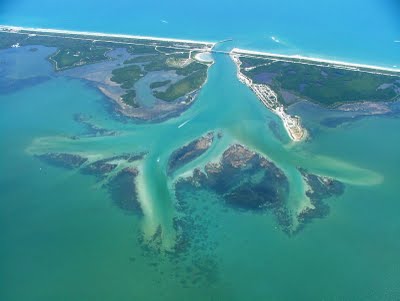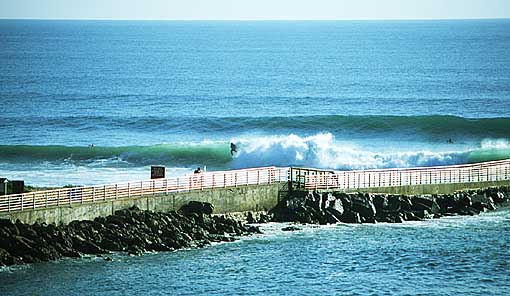Discover Florida Nature
It's time to explore the natural Florida


|
|
|
|
|
 Sebastian
Inlet State Park is a Florida State Park located 10 miles south of
Melbourne Beach and 6 miles north of Vero Beach, Florida. The park lies
on both sides of the Sebastian Inlet, which forms the boundary between
Brevard and Indian River counties. The land for the park was acquired by
the state of Florida in 1971. In 2006, it was the sixth most visited
state park in Florida. The park occupies 755 acres on the barrier island
on the Atlantic coast of Brevard
County, at a point where a channel links the Indian River
Intracoastal waterway
with the Atlantic. Part of the Park is south of the Inlet on Orchid
Island in Indian River County. Sebastian
Inlet State Park is a Florida State Park located 10 miles south of
Melbourne Beach and 6 miles north of Vero Beach, Florida. The park lies
on both sides of the Sebastian Inlet, which forms the boundary between
Brevard and Indian River counties. The land for the park was acquired by
the state of Florida in 1971. In 2006, it was the sixth most visited
state park in Florida. The park occupies 755 acres on the barrier island
on the Atlantic coast of Brevard
County, at a point where a channel links the Indian River
Intracoastal waterway
with the Atlantic. Part of the Park is south of the Inlet on Orchid
Island in Indian River County.The premier saltwater fishing spot on Florida's east coast, this park is a favorite for anglers nationwide for catching snook, redfish, bluefish, and Spanish mackerel from its jetties. Surfing is also a popular recreation and several major competitions are held here every year. Three miles of beautiful beaches provide opportunities for swimming, scuba diving, snorkeling, shelling, and sunbathing. Canoeing and kayaking in the Indian River Lagoon are also favorite pastimes. Visitors can relax with a stroll down the mile-long Hammock Trail. Waterfront pavilions and picnic areas are great for family outings. The park mainly provides leisure activities, particularly fishing from both its Atlantic and Indian River shores; fishing jetties extend from both sides of the inlet into the ocean. There are facilities for swimming, surfing, snorkeling and scuba diving from the 3 miles of Atlantic beach. Boats can be launched into the Indian River, and there is a marina complex at the north end of the park. Camping is permitted in designated area. Wildlife is abundant in the park, and the casual visitor can reasonably hope to see ospreys and many species of shorebird. Sea turtles nest in the park, and visitors during the summer may make reservations for a nighttime foray to observe nesting Loggerhead Turtles.  The
history of the Sebastian Inlet area goes back to the end of the last ice
age. The barrier islands formed from sandbars off the coast of the
mainland. As vegetation took hold on the sandbars, animals moved in,
followed by the first human inhabitants, the Paleo hunters. The
Ais Indians were more recent inhabitants of the
barrier islands. They were a tribe of hunters and gatherers who lived
off the bounty of the land and sea. By 1760, all of the Ais Indians were
gone. Like the other natives of Florida, they succumbed to European
diseases and mistreatment. The
history of the Sebastian Inlet area goes back to the end of the last ice
age. The barrier islands formed from sandbars off the coast of the
mainland. As vegetation took hold on the sandbars, animals moved in,
followed by the first human inhabitants, the Paleo hunters. The
Ais Indians were more recent inhabitants of the
barrier islands. They were a tribe of hunters and gatherers who lived
off the bounty of the land and sea. By 1760, all of the Ais Indians were
gone. Like the other natives of Florida, they succumbed to European
diseases and mistreatment.Two museums provide a history of the area. In 1715, eleven Spanish treasure galleons sank along the east central Florida coast. One of the survivors’ campsites was located on the present day site of the McLarty Treasure Museum. Seven hundred people lost their lives in this disaster, while 1,500 people survived. Situated on a survivors’ camp of this ill-fated 1715 Spanish Plate Fleet, the museum features artifacts, displays, and an observation deck that overlooks the Atlantic Ocean. An Arts and Entertainment production—The Queen’s Jewels and the 1715 Fleet— is shown, telling of the fleet’s return to Spain when a hurricane struck off the Florida coast nearly 300 years ago. Still today, salvagers work to recover gold, silver, and the "Queen’s jewels" that were lost to the sea and its sandy shores. The Sebastian Fishing Museum tells the history of the area's fishing industry. The Sebastian Fishing Museum is devoted to educating the public on the rich cultural history of Sebastian’s fishing industry. The lives and history of the people who lived in Sebastian were interwoven with fishing and the Indian River Lagoon. The lagoon provided food, transportation and a means of livelihood for many of Sebastian’s early residents. The commercial fishing industry helped make Sebastian what it is today. The Sebastian Fishing Museum commemorates three of Sebastian’s early families that operated fish houses: Sembler, Smith, and Judah. Inside the museum you will find a replica of an original fish house and dock, the traditional heart of the industry. A homemade fishing boat, nets, fishing gear, and photos of fishing in the Indian River Lagoon are also on display. A 24-minute video presentation explores the history and vast diversity of the wildlife within the Indian River Lagoon. |
|
|
Sebastian Inlet State Park Florida
Sebastian Inlet State Park is a Florida State Park located 10 miles south of Melbourne Beach and 6 miles north of Vero Beach, Florida. The park lies on both sides of the Sebastian Inlet. In 2006, it was the sixth most visited state park in Florida. Wildlife is abundant in the park, and the casual visitor can reasonably hope to see ospreys and many species of shorebird. Sea turtles nest in the park, and visitors during the summer may make reservations for a nighttime foray to observe nesting Loggerhead Turtles.
Sebastian Inlet State Park is the premier saltwater fishing spot on Florida's east coast, this park is a favorite for anglers nationwide for catching snook, redfish, bluefish, and Spanish mackerel from its jetties. Surfing is also a popular recreation and several major competitions are held here every year. Three miles of beautiful beaches provide opportunities for swimming, scuba diving, snorkeling, shelling, and sunbathing. Canoeing and kayaking in the Indian River Lagoon are also favorite pastimes. Visitors can relax with a stroll down the mile-long Hammock Trail. Waterfront pavilions and picnic areas are great for family outings. The park mainly provides leisure activities, particularly fishing from both its Atlantic and Indian River shores; fishing jetties extend from both sides of the inlet into the ocean. There are facilities for swimming, surfing, snorkeling and scuba diving from the 3 miles of Atlantic beach. Boats can be launched into the Indian River, and there is a marina complex at the north end of the park. Camping is permitted in designated area. Sebastian Inlet State Park is a must visit for Floridian nature lovers!
Written by: Floridian Nature
Sebastian Inlet State Park
Date published: 10/23/2013
5 / 5 stars
|
|